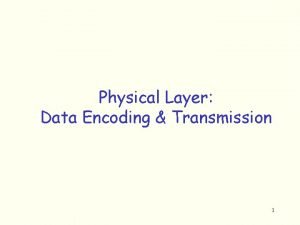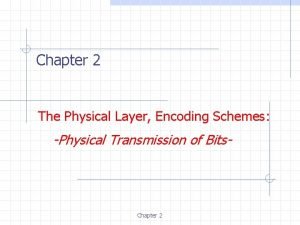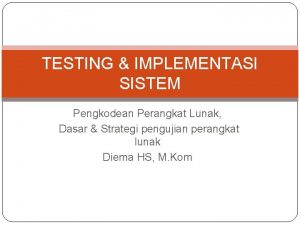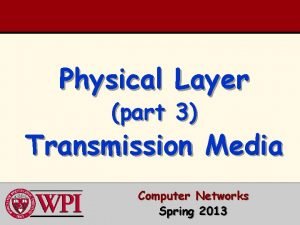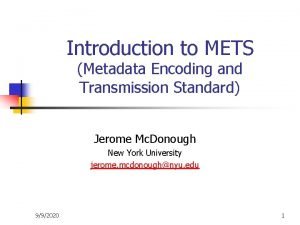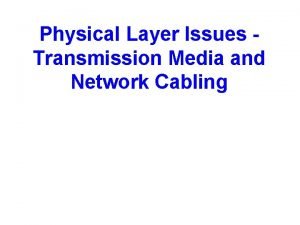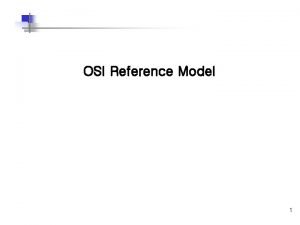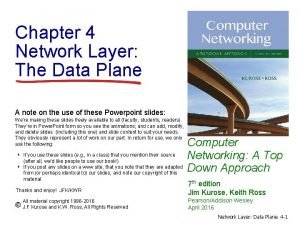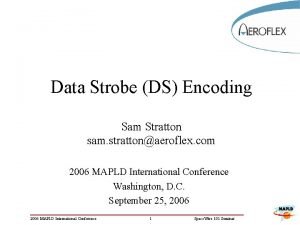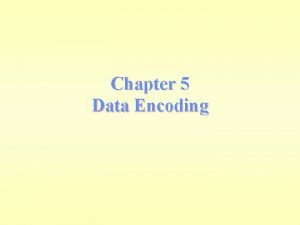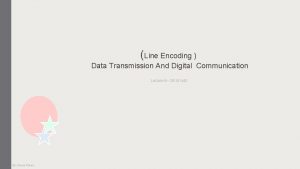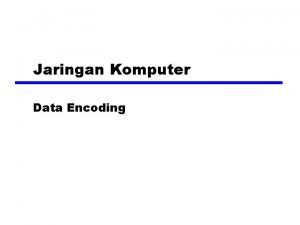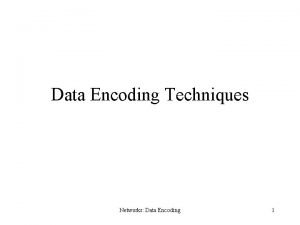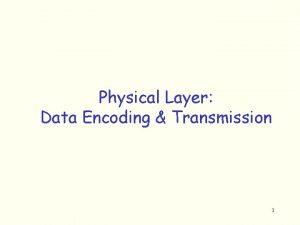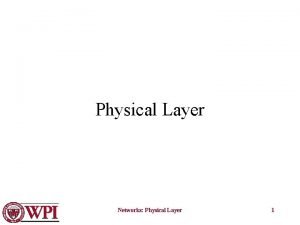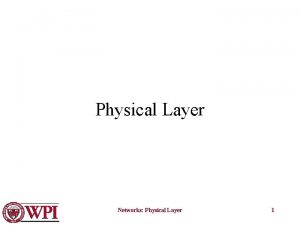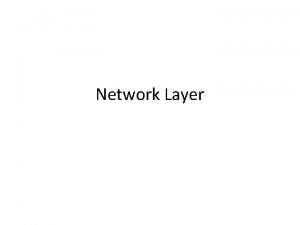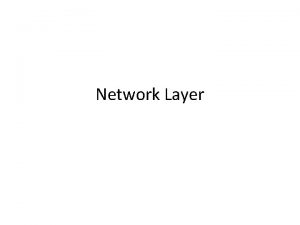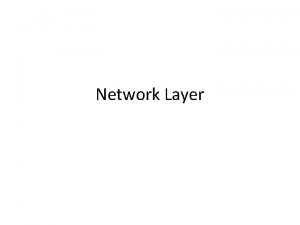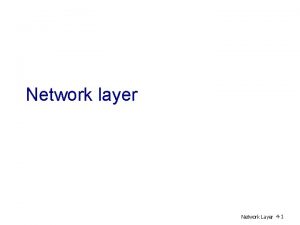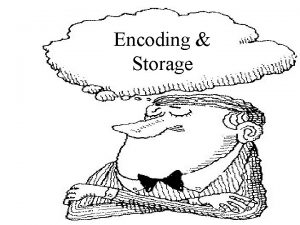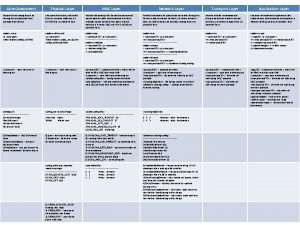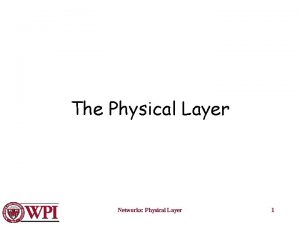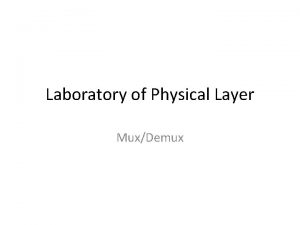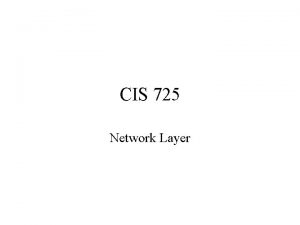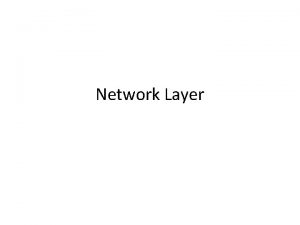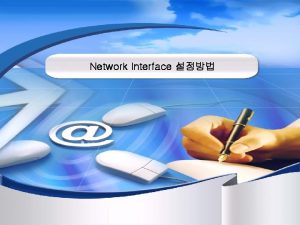Physical Layer Data Encoding Transmission 1 Network Interface





















- Slides: 21

Physical Layer: Data Encoding & Transmission 1

Network Interface Card (NIC) Link Interface CPU cache Link interface Bus interface NIC Memory I/O Bus Link I/O Bus Interface PCI Link Interface • LL in part, PL in total are implemented in NIC – Ethernet card, 802. 11 card, … – NIC is semi-autonomous • Listens to the link independent of the CPU • Talks to CPU after reception of a new frame • CPU talks to the card to send a frame – Has connectivity to both the I/O bus and the network link 2

Steps in Transmission of a Datagram to a Neighbor Datagram H Y LL Datagram LL H Datagram Encode Bits to the Link Datagram All bits in D’ OK? Detected error D’ EDC PL PL N EDC‘ Decode Bits from the Link Bit error prone link 3

Encoding - Definitions • Data: Something which carries meaning – Can be analog, e. g. , radio, TV signals or digital such as data files etc. – For this course, we are ONLY interested in digital data encoding • Signal: Encoded data, i. e. , what is transferred on the link (wired or wireless) – Analog: Represents data with continuously varying electromagnetic waves – Digital: Represents data with a sequence of voltage pulses Datagram H Datagram LL Frame EDC Add Framing Information LL Encode Bits to the Link PL Link 4

Encoding Digital Data • Digital Data (0 s and 1 s) can be encoded as an Analog Signal – Signal on the link is an electromagnetic wave of some frequency – Signal can also be photonic pulses of a given wavelength over optical fiber • 3 general methods – Amplitude Shift Keying – Frequency Shift Keying – Phase Shift Keying 5

Digital Data to Analog Signal: ASK Digital Data = m(t) Modem Analog Signal = s(t) = A cos(2*PI*fc*t) – binary 1 s(t) = 0 – binary 0 6

Digital Data to Analog Signal: FSK Digital Data = m(t) Modem Analog Signal = s(t) = A cos(2*PI*f 1*t) – binary 1 s(t) = A cos(2*PI*f 2*t) – binary 0 7

FDM + FSK on Voice Grade Line • Full-duplex FSK transmission on a Voice-Grade Line: – The frequency band 300 Hz-3400 Hz is divided into to halves: • 300 Hz-1850 Hz & 1850 -3400 Hz – Frequency Division Multiplexing – Then – Frequencies 2025 & 2225 are used to encode 1 and 0 in one direction – Frequencies 1070 & 1270 are used to encode 1 and 0 in the other direction 8

Digital Data to Analog Signal: PSK Digital Data Analog Signal Modem s(t) = A cos(2*PI*fc*t + PI) – binary 1 s(t) = A cos(2*PI*fc*t) – binary 0 QPSK uses s(t) = A cos(2*PI*fc*t + PI/4) – binary 11 s(t) = A cos(2*PI*fc*t + 3*PI/4) – binary 10 s(t) = A cos(2*PI*fc*t + 5*PI/4) – binary 00 s(t) = A cos(2*PI*fc*t + 7*PI/4) – binary 01 • Each signaling element carries 2 data elements – – Signaling element rate: Baud-rate Data element rate: Bit-rate 9

Encoding Digital Data • Digital Data (0 s and 1 s) can also be encoded as a “Digital Signal” – – Signal on the link are discrete, discontinuous voltage pulses Each pulse is a signal element Binary data encoded into signal elements E. g. , 2 voltage levels, one of them representing digital 0, the other one representing digital 1 • Lots of different encoding methods – – – – Non-Return to Zero (NRZ) Manchester Encoding 4 B/5 B NRZ-I NRZ-M Bi-Phase-Mark, Bi-Phase-Space Differential Bi-Phase-Space, Differential Bi-Phase-Mark … 10

Digital Data to Digital Signal: NRZ Digital Data Digital Signal Encoder • Non-Return to Zero (NRZ) – 1=high signal (+5 V), 0=lower signal (-5 V) – One-to-one correspondence between data & signal 0 1 0 0 1 1 0 0 0 1 1 Digital Data Digital Signal 11

Manchester Encoding • Manchester Encoding – Used in Ethernet – 0 is encoded as low to high transition – 1 is encoded as high to low transition – Not very efficient • Signaling rate (baud-rate) is twice the data rate (bit-rate) 0 1 0 0 1 1 0 0 0 1 1 Digital Data Clock Digital Signal 12

4 B/5 B • Attempts to address the inefficiency of the Manchester encoding without suffering from the problem of having extended durations of high or low signals as was the case in NRZ • Idea is to insert extra bits into the bit stream so as to break up long sequences of 0 s and 1 s – Specifically, every 4 -bit of actual data is encoded into a 5 -bit code that is then transmitted to the receiver using NRZI 4 -bit Data Symbol 0000 0001 0010 0011 0100 0101 0110 0111 5 -bit Code 11110 01001 10100 101010 01011 01110 01111 4 -bit Data Symbol 1000 1001 1010 1011 1100 1101 1110 1111 5 -bit Code 10010 10011 10110 10111 11010 11011 11100 11101 13

Encoding Digital Data • Why use an analog signal to carry digital data? – Because some mediums only propagate analog signals • Optical fiber, air (unguided media) – Because the network was designed to receive, switch and transmit analog signals • PSTN handles analog signals in the voice range of about 300 -3400 Hz. • Why do digital data-to-digital signal encoding? – Equipment for encoding digital data into digital signal is less complex and less expensive 14

Transmission of Encoded Data Sender Receiver Digital Signal NRZ • After encoding the digital data, the sender simply puts the signal on the wire as shown above • How does the receiver decode this signal? – Receiver must sample on the middle of each signaling element as shown above • Problem: – How do you synchronize the sender & receiver clocks? 15

Sender/Receiver Clocking • Timing problems require a mechanism to synchronize the sender and the receiver • Two mechanisms – Provide a separate line to send the clock signal from the sender to the receiver. The receiver then uses the same clock to decode the incoming signal • OK for short distances, but not practical for long distances • Way too $$ – Let the sender and receiver use independent clocks • Independent clocks can easily get out of sync. Then, • Have the receiver synch its clock from the incoming signal • Called Self-Clocking 16

Self-Clocking Transmission • Two ways to sync the sender and the receiver during self-clocking transmission – Asynchronous Transmission • Data transmitted one character at a time with start/stop bits – Each char is 5 to 8 bits • Timing only needs to be maintained within each character • Re-sync after each character – Synchronous Transmission • Data transmitted as a stream of bits with no start or stop bits • The receiver must synch itself using the incoming signal – Signal must have enough transitions to let the receiver sync itself from the signal 17

Asynchronous (diagram) 18

Asynchronous - Behavior • In a steady stream, interval between characters is uniform (length of stop element) • In idle state, receiver looks for transition 1 to 0 – Start bit • Then samples next 7 or 8 intervals (char length) • Then looks for next 1 to 0 for next char • • • Simple Cheap Overhead of 2 or 3 bits per char (~20%) Good for data with large gaps (keyboard) Used in RS-232 Serial Port Communication 19

Synchronous Transmission • Block of data transmitted without start or stop bits • How to synchronize clocks? – Need to have enough transitions on the signal • Manchester encoding: a transition for every bit makes clock recovery easy • 4 B/5 B: Make sure there will be enough transitions within the signal regardless of the bit-stream, while keeping the overhead at 20% -- Used by some Ethernets • NRZ: Long stream of 0’s or 1’s make clock recovery almost impossible. So NRZ is almost never used in synchronous transmission 20

Summary • Covered Digital Data Encoding Methods – Digital Data-to-Analog Signal Encoding (Modulation) • ASK • FSK • PSK – Digital Data-to-Digital Signal Encoding • • NRZ Manchester 4 B/5 B … • Covered transmission of encoded data over the link – Asynchronous Transmission: Data transmitted one character at a time with start/stop bits – Synchronous transmission: Data transmitted as a stream of bits with no start or stop bits 21
 Physical layer encoding
Physical layer encoding Physical layer encoding
Physical layer encoding Data encoding and transmission
Data encoding and transmission Testing dikatakan baik, jika
Testing dikatakan baik, jika Physical layer transmission media
Physical layer transmission media كبيل
كبيل Metadata encoding and transmission standard
Metadata encoding and transmission standard Transmission media
Transmission media Ois 7계층
Ois 7계층 Comparison of virtual circuit and datagram subnets
Comparison of virtual circuit and datagram subnets Network layer data plane
Network layer data plane Interface in java
Interface in java Abowd and beale framework example
Abowd and beale framework example Industrial interfaces
Industrial interfaces Interface------------ an interface *
Interface------------ an interface * Strobe of data
Strobe of data Encoding data
Encoding data Line coding in data communication
Line coding in data communication Signal encoding schemes
Signal encoding schemes Data encoding
Data encoding Data encoding techniques
Data encoding techniques Pigmented layer and neural layer
Pigmented layer and neural layer
